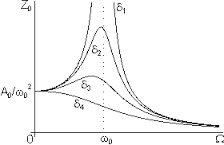Example
Solve problems on damped oscillations using small damping approximation
Example: In a damped oscillator with , , and , the ratio of the amplitude of the damped oscillations to the initial amplitude at the end of cycles is given as . Find .
Solution:The time period of this system is given by
For cycles, time taken will be
So the ratio of amplitude after cycles to that of initial amplitude is
Solution:The time period of this system is given by
For cycles, time taken will be
So the ratio of amplitude after cycles to that of initial amplitude is
Formula
Find time period of oscillation assuming small damping
As
Example
Find external force in forced oscillation
Example: A simple harmonic oscillator is of mass . It is oscillating with a frequency of Hz. If its amplitude of vibration is cm, what is the force acting on the particle at its extreme position?
Solution:
Solution:
Example
Frequency of oscillations in forced oscillations
Example: A kg block hangs without vibrating at the bottom end of a spring with a force constant of N/m. The top end of the spring is attached to the ceiling of an elevator car. The car is rising with an upward acceleration of m/s when the acceleration suddenly ceases at time and the car moves upward with constant speed ( m/s) What is the angular frequency of oscillation of the block after the acceleration ceases?
Solution:
Given : Mass of the block
Spring constant
Let angular frequency of the oscillation be .
Now using
Solution:
Given : Mass of the block
Spring constant
Let angular frequency of the oscillation be .
Now using
Definition
Write displacement as a function of time in forced oscillation
The object oscillates about the equilibrium position . If we choose the origin of our coordinate system such that , then the displacement from the equilibrium position as a function of time is given by:
Example
Examples of mechanical resonance
Various examples of mechanical resonance include:
1. Musical instruments (acoustic resonance).
2. Most clocks keep time by mechanical resonance in a balance wheel, pendulum, or quartz crystal.
3. Tidal resonance of the Bay of Fundy.
4. Orbital resonance as in some moons of the solar system's gas giants.
5. The resonance of the basilar membrane in the ear.
6. Making a child's swing, swing higher by pushing it at each swing.
7. A wine glass breaking when someone sings a loud note at exactly the right pitch.
1. Musical instruments (acoustic resonance).
2. Most clocks keep time by mechanical resonance in a balance wheel, pendulum, or quartz crystal.
3. Tidal resonance of the Bay of Fundy.
4. Orbital resonance as in some moons of the solar system's gas giants.
5. The resonance of the basilar membrane in the ear.
6. Making a child's swing, swing higher by pushing it at each swing.
7. A wine glass breaking when someone sings a loud note at exactly the right pitch.
Definition
Oscillations when driving frequency is close to natural frequency

Amplitude of oscillations in shown in the attached plot and given by the formula:
where
Driving Force
Mass
Driving Frequency
Damping Frequency and Damping constant
When , amplitude of oscillations is maximum.
which is a very large value.
This is the phenomenon of resonance in forced oscillations.
where
Driving Force
Mass
Driving Frequency
Damping Frequency and Damping constant
When , amplitude of oscillations is maximum.
which is a very large value.
This is the phenomenon of resonance in forced oscillations.
Diagram
Displacement time graph for different oscillations

Definition
Explain maintained oscillation with example
Maintained Oscillation : In maintained oscillation, energy is supplied to the system from outside at the same rate at which the energy is lost by it, so that its amplitude remains constant & the system oscillates with its own natural frequency. Example: Swing, electric tuning fork, balance wheel of a watch, etc
Definition
Free vibrations
The periodic vibrations of a body of constant amplitude in the absence of external force are called free vibrations. Some examples of free vibrations are oscillations of simple pendulum, oscillations of object connected to a horizontal spring, sound produced by tuning fork in short distance, notes of musical instruments, organ pipe, etc.
Result
Nature of free vibrations
Amplitude and frequency of a freely vibrating body remains constant. They do not lose or gain any energy in the process. Free vibrations for sound can occur only in vacuum. Such vibrations are ideal conditions of oscillations. It is not possible to practically realize free vibrations.
Definition
Forced vibrations
Vibrations of a body under the constant influence of an external periodic force acting on it are called the forced vibrations. The external applied force is called the driving force. Amplitude of body oscillating under forced oscillations can be decreasing, constant or increasing depending on various factors like difference in amount of driving force and resistive force, difference in frequency of driving force and actual vibrations and difference in phase of driving force and actual vibrations.
| BookMarks |
Page 11 Page 12 Page 13 Page 14
0 Comments
Post a Comment